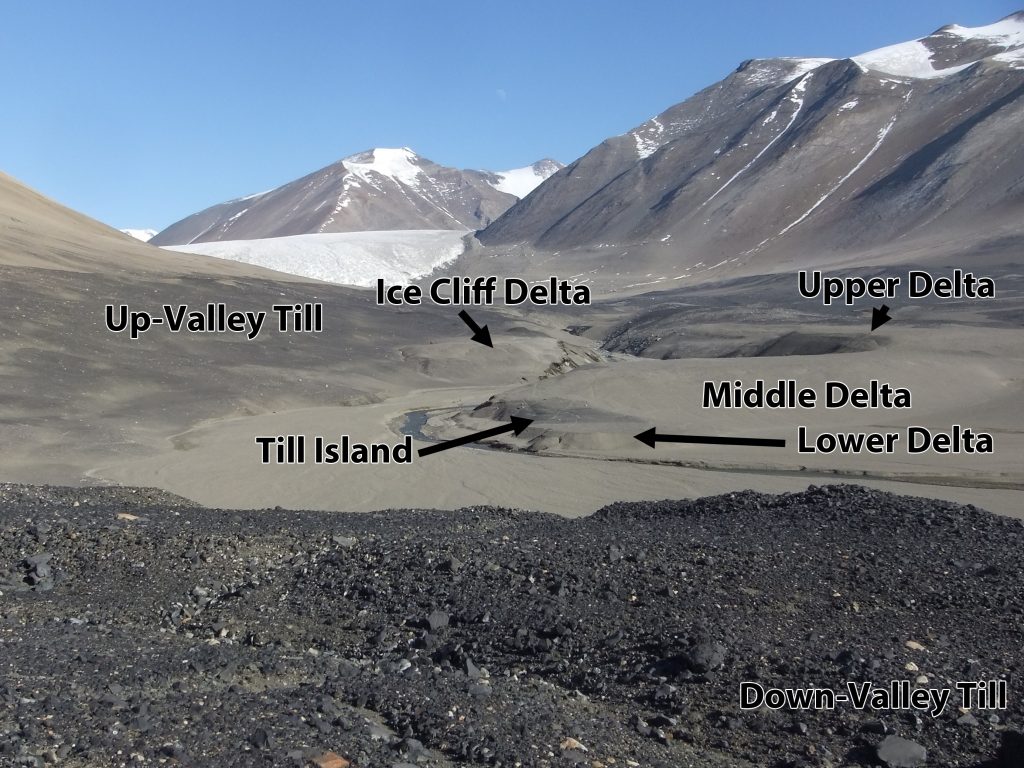A new study by UTIG Research Associate Joseph Levy used new dating techniques to determine that Antarctic paleolakes that grew during the last ice age stuck around much longer than previously thought. The study, “Luminescene dating of paleolake deltas and glacial deposits in Garwood Valley, Antarctica: Implications for climate, Ross ice sheet dynamics, and paleolake duration was published in The Geological Society of America Bulletin.
“What this means is that the leftover deposits from these paleolakes are telling us a brand new story,” said Levy.
The research used both old-fashioned radiocarbon dating and newer optically/infrared stimulated luminescence (OSL) dating techniques. The OSL technique dates sediment directly, instead of relying on algal mats and other organic matter as used by radiocarbon methods. By using both, the research team was able to compare the ages from the same levels of the ancient lake. What they found was that radiocarbon dates were consistently older than OSL results, in some cases up to 10 thousand years.
So why use a new method? Levy explains that even in the best published radiocarbon studies are limited to the handful of locations where organic matter can be found within the deposits. Large sections of the deposits don’t have enough organic matter in them to decode the complete history. In addition, there were clues that some ancient carbon samples had been naturally contaminated by carbon from local rocks.
“For the Garwood deltas, there was a lot of the delta that had no organic matter in it. Luminescence dating measures when the sediment is deposited directly, so it let us measure dates all the way to the end of the formation of the deltas. This is like “reading to the end of the book” of their history by measuring dates right up to the top of the deltas,” he said.
Levy and the team found that the demise of the ancient lake in Garwood Valley, named Howard Lake, was not directly controlled by the Ross Sea ice sheet grounding line position, as was previously thought. Rather, the ancient lake persisted for thousands of years longer than previously through, dammed up by stranded ice in the Garwood Valley. They conclude that the use of both radiocarbon and OSL dating techniques can help better understand the relationships between paleolakes, glacier melt, and stream discharge in response to climate changes, in the past and today.
Levy hopes that this study will have two impacts:
“I hope that it sheds light on the fact that there were relatively recent, long-lived lakes in the terrestrial parts of Antarctica that could be used to collect paleoclimate proxies for reconstructing what’s going on at the Antarctic coast. We think of Antarctica as only producing climate history information from ice cores, but these lakes were probably much longer lived than previously thought,” Levy said. “The second impact is that this may help reinterpret how folks make sense of ocean sediment deposits. When cores from the Ross Sea region do or don’t show terrestrial sediment entering the sound, it may be because some of it is getting trapped behind these long-lived ice dams. Correlating the ocean and land record in Antarctica is the next big challenge.”
Read the full article in the latest issue of Geological Society of America Bulletin.

